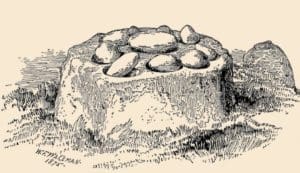The Matriarchal Societies of China’s Mosuo: An Insight into Female-Led Culture

Updated On: May 01, 2024 by Asmaa Alhashimy
In the mountainous regions where the provinces of Yunnan and Sichuan converge, there lies a society that defies the commonly held norms of patrilineage. The Mosuo, known as the ‘Kingdom of Women’, stands as one of the few remaining matriarchal societies in the world. Here, women play the central role in leadership, inheritance, and social structures, marking a stark contrast to the patriarchal framework that dominates much of the globe.

Living beside the picturesque Lugu Lake, the community maintains a matrilineal system where property and family names are passed down through the female line. This unique social structure emphasises the importance of females in governance and household decision-making. Within this community, traditional gender roles are turned on their head, showcasing an intricate social fabric that values the contributions and authority of women in both the domestic and public spheres.
Historical Context
In discussing the historical context, we touch upon the ancient matriarchal traditions that have defined their society, explore the influence of Tibetan Buddhism on their culture, and consider the impact of Chinese governmental policies over the years.
Ancient Traditions and Origins
The Mosuo people, residing by Lake Lugu in Yunnan, represent one of the few remaining societies in China where matriarchal and matrilineal structures are prevalent. These traditions have ancient roots, dating back to a time before written records. They are known for their ‘walking marriages’ and women occupying central roles in both the family and community. Property and family names are passed down through the female line, upholding a matrilineal system that has survived through the centuries.
Influence of Tibetan Buddhism
Tibetan Buddhism has been integral to their way of life, intermingling with their indigenous faith, Daba. This combination of beliefs has contributed to the matriarchal structure of their society, where women are revered as the embodiment of both spiritual and familial authority. The spiritual practices derived from Tibetan Buddhism continue to influence Mosuo customs and societal roles.
Impact of Chinese Government Policies
Starting with the Cultural Revolution, Mosuo’s unique way of life was under scrutiny by the Chinese government. Policies aimed at homogenizing China’s ethnic groups posed a threat to their ancient traditions. However, despite historical pressures, they have managed to preserve much of their heritage. In recent years, governmental policies have shifted, partially in recognition of their role in promoting cultural diversity and tourism in the region.
Geographical Setting

As we explore the heartland of the Mosuo people, it’s important to recognise the significant role that geography plays in shaping their unique matriarchal society.
Lugu Lake: The Heartland
Lugu Lake, nestled at the border between Yunnan and Sichuan provinces in China, serves as the central axis of Mosuo culture. This alpine lake is often referred to as the “Mother Lake”, with many of their villages dotting its periphery. At an altitude of about 2,700 meters, Lugu Lake is not only a stunning natural wonder but also a cultural hub, where women lead family structures and social organizations.
The High Himalayas Influence
Their proximity to the High Himalayas exerts a profound influence on their way of life. The rugged terrain and reduced oxygen levels at higher altitudes demand resilience and adaptation, traits that they have honed over centuries. This geographical challenge is met with a communal spirit and shared responsibilities, often centred around the women, who are integral to the community’s endurance and cultural identity within these imposing mountains.
The Social Fabric
In the heart of China’s mountainous landscapes, we find the Mosuo culture, a society that stands as a testament to matriarchal social structures. This section peels back the layers of their unique social fabric, where women play pivotal roles and where familial lines are traced through maternal roots.
Matrilineal Family Structure
At the core of the Mosuo’s societal weaving is the matrilineal family structure. Here, ancestry and inheritance are passed down through the female line. Children take the surname of their mothers, and maternal ties are central to all aspects of family and social life. These deep-rooted matrilineal traditions have been carefully preserved over generations within families, placing the Mosuo among one of the last societies to maintain this practice.
Role of Matriarchs
In Mosuo culture, matriarchs are the robust threads binding the family tapestry together. Women, as head of the household, guide the family on matters ranging from financial decisions to domestic affairs. Revered not merely as leaders but as custodians of ancestral wisdom and customs, these matriarchs command respect and contribute significantly to the cohesiveness and resilience of their society. Their role underscores the community’s reverence for the female lineage, positioning them as integral to the fabric of their matrilineal family structure.
Gender Dynamics and Relationships
In the Mosuo society, known for its matriarchal structure, gender dynamics and relationships are defined in ways that are distinct from the patriarchal norms observed globally. Our exploration delves into the concepts of walking marriages and the empowerment of women within their social roles.
Concept of Walking Marriages
In Mosuo culture, the practice of ‘walking marriages’ is emblematic of the community’s unique approach to relationships. Rather than adhering to the traditional institution of marriage, women may choose to have ‘walking marriages’ — a form of relationship where partners do not live together and the men visit the women’s houses at night. Sexual freedom is a key component, with neither party bound by the commitments of conventional marriage, and they may choose to end the relationship at any time without social stigma. Children born from such unions are raised in the mother’s household, emphasising the central role of motherhood within the societal fabric.
Female Empowerment and Social Roles
The Mosuo societal structure places women in primary positions of power both within the family and the community. Women are the heads of households and control wealth and decision-making, which stands in contrast to typical matriarchal societies. The women carry the lineage and inheritance rights, and their authority extends to religious and cultural ceremonies. This social system allows them to undertake significant roles in the community, underscoring the degree of female empowerment that characterises them.
Cultural Practices
In the matriarchal society of the Mosuo, their cultural practices are deeply woven into their daily life, reflecting a rich heritage that has been passed down through generations. These traditions are not only a testament to their past but also a living aspect of their community’s identity.
Festivities and Rituals
The Mosuo participate in various traditional festivities and rituals that are integral to their cultural fabric. One of the most significant celebrations is the annual Zuicun Festival, which honours their matriarchal structure. During this festival, families gather to pay tribute to their ancestors and acknowledge the women who have contributed to their lineage. These celebrations are characterised by colourful costumes, spirited dancing, and communal meals, emphasizing togetherness and the matriarchs’ central role.
Another tradition is the Daba practice — a type of shamanistic ritual. Daba priests are responsible for conducting ceremonies that include offerings and recitations intended to communicate with the spirits and ensure harmony within the community.
The Luoshu Script
A unique form of expression is the Luoshu script. This pictographic writing system has been historically used for record-keeping and religious texts. Although knowledge of Luoshu has declined over the years, there has been a concerted effort to preserve this aspect of their cultural tradition. The script itself features intricate symbols that represent various concepts and objects, offering a fascinating glimpse into the intellectual and artistic legacy of the Mosuo people.
Economic Aspects
In exploring the Mosuo’s economic landscape, we discover a community deeply rooted in both tradition and adaptability. Our analysis discloses how agricultural practices underpin society’s sustenance while tourism introduces new economic opportunities and challenges.
Agriculture and Self-Sustenance
At the heart of the Mosuo’s economy lies their agricultural activities. As a tribe, we maintain a strong connection to the land, with our livelihoods centred around farming and livestock herding. This self-sustaining approach ensures our basic needs are met, fostering a sense of communal support and resilience. The Mosuo’s agricultural base contributes to our collective autonomy and is fundamental in safeguarding us from the grips of poverty.
Tourism and External Influences
Tourism presents a complex juxtaposition of economic development and cultural integrity. As we open our doors to travellers attracted by our unique matriarchal structure, we witness a boost in local revenue streams. The allure of experiencing one of the world’s last matriarchal societies has positioned us on the global stage, providing economic upliftment, albeit with new pressures.
Our engagement with tourism has led us to encounter the forces of modernisation and global travel paradigms, reshaping some aspects of our way of life. However, we have remained unwavering in our commitment to upholding our cultural values amid these shifting tides.
Housing and Daily Living
In the unique matrilineal society of the Mosuo, housing and everyday life are centred around their customs, with women playing a central role in managing these spaces.
A Typical Mosuo Home
A typical Mosuo home is often a multi-storied structure made of timber and stone. These homes are designed to accommodate the extended family, reflecting the Mosuo’s communal living arrangements. At the core of each household is the fire pit, serving both as a cooking hearth and a gathering spot for family members. These homes are usually led by the eldest woman, often referred to as the Ah mi, who holds the responsibility for making key decisions, including those related to the property.
The living spaces are communal, yet private rooms are designated for “walking marriages,” a unique practice where the male partners visit the female’s room at night. It’s important to note that Mosuo children are raised in the mother’s home without a permanent paternal presence; the bloodline and family name extend through the female members.
Within a Mosuo home, the care and upbringing of children is a shared responsibility. The concept of a nuclear family, common in Western societies, is not present; instead, children are cared for by all relatives, forging strong bonds within the wider family unit. By growing up in such inclusive households, Mosuo children experience a sense of security and community from an early age.
These distinctive elements of a Mosuo home emphasise not only the matrilineal nature of the society but also the deep-seated cultural traditions that are preserved and passed on through generations.
Perspectives on Mosuo Society
In examining the Mosuo society, various perspectives shed light on their unique cultural traditions, from academic insights to personal narratives and observations by outsiders.
Anthropologists’ Views
Anthropologists have long been fascinated by the Mosuo’s matrilineal structure, where lineage and inheritance are passed down through the female line. This societal organisation challenges the traditional patriarchal norms found in many other cultures. Anthropological studies highlight that Mosuo women are central to decision-making within their households and in managing the family’s resources. Through their research, anthropologists aim to understand how this cultural tradition affects dynamics within the Mosuo tribe and the broader implications for gender roles in society.
First-hand Accounts by Choo Waihong
Choo Waihong offers an invaluable perspective into the lives of the Mosuo through her immersive experience, living among them and documenting their daily lives. Her narratives provide a direct window into the way the Mosuo have maintained their matriarchal system amidst modern societal pressures. Her writings portray both the strengths and challenges of Mosuo society, illustrating how they navigate the intersection of tradition and modernity. Choo’s account of the decline of Mosuo’s culture serves as an important documentation of this unique societal structure.
The Mosuo Through Tourist Eyes
Tourists who visit Mosuo communities often leave with a sense of wonder at the distinct cultural practices they observe. From a foreigner’s standpoint, the Mosuo way of life can offer refreshing insights into alternative familial and social systems. However, it’s crucial to consider that tourism can affect the authenticity of the cultural experiences on display. While visitors may provide an external perspective on the Mosuo — fuelled by curiosity and admiration — their interpretations are through the lens of a tourist’s eyes, which can sometimes simplify or misrepresent the complexities of their life.
Challenges and Changes
The Mosuo of China, often described as a ‘kingdom of women’, faces a complex interplay between tradition and modernity. Across generations, their matriarchal structure has encountered both internal and external pressures for change. Family dynamics, increasing tourism, and echoes of the Cultural Revolution all serve as catalysts in this evolving narrative.
Modern Influences and Adaptations
As society evolves, the Mosuo are witnessing significant shifts in their family structure. The once common practice of matrilineal inheritance is battling against modern influences that promote more nuclear family ideals. Elder Mosuo recall a time of collective decision-making and shared resources, but today there is a slow pivot towards individualism. Tourism has become a double-edged sword, bringing both economic benefits and cultural assimilation. It enables many Mosuo to preserve their homes and traditions through the income it generates; however, the exposure to global ideas often leads younger generations to question and sometimes replace the old ways with newer family constructs.
Preservation of Culture vs. Globalisation
Globalisation brings a deep tension between sustaining Mosuo culture and integrating into the wider world. During the Cultural Revolution, the Mosuo were pressured to conform to mainstream Chinese societal norms, leading to a reduction of their matrilineal practices. Now, as globalisation intensifies, there is a delicate balance between protecting the Mosuo culture and embracing necessary changes. On one hand, efforts are made to shield the essence of their tradition; on the other, there is an acceptance that certain adjustments are inevitable for survival in a connected world. We find that Mosuo’s way of life is resilient, which captures the interest of external observers and garners support for its preservation.
Their Future

As we examine the community, one of the world’s enduring matriarchal societies, we are offered a glimpse into a unique social structure that has withstood the test of time amidst significant economic development.
Potential Paths
The Mosuo people, residing near Lugu Lake, have garnered attention for their matrilineal system, where women lead households and inheritance is passed down through the female line. This cultural hallmark faces pressures from the outside world, predominantly in terms of economic development and tourism. As commerce and industry evolve, they bring both challenges and opportunities to their society.
Our community’s future may veer towards incorporating modern economic practices while striving to preserve its cultural identity. The tourism industry has become intrigued by the Mosuo way of life, leading to a curious symbiosis of tradition and commerce. However, it is crucial to balance this with the community’s values to ensure sustainability and respect for Mosuo heritage.
Continued research and dialogue with the Mosuo could provide avenues for empowerment through education and enterprise without compromising their matriarchal ethos. It’s imperative that any economic transitions honour and maintain the essence of the Mosuo’s social fabric. Therefore, we stand on the brink of potential social transformation that must be navigated with sensitivity and foresight.






